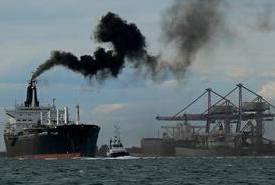 有鑒于美國環保署倡議的一項有關改善全國各地空氣質量的條例,未來懸掛美國國旗的遠洋船隻,將面臨更嚴苛的柴油發動機和燃料標準。
有鑒于美國環保署倡議的一項有關改善全國各地空氣質量的條例,未來懸掛美國國旗的遠洋船隻,將面臨更嚴苛的柴油發動機和燃料標準。
該提案除了對新的柴油引擎大型船舶,提出更嚴格的廢氣排放標準外,同時要求貨櫃輪、油輪、散裝貨輪、遊輪等大型船舶使用硫含量較低的柴油。
這項條例乃是繼美國和加拿大于今年3月提出的議案,將兩國數千英里長的海岸指定為排放管制區(Emission Control Area, ECA)後發起的。
隸屬於聯合國機構的國際海事組織,本月開始審議其排放管制區計劃。如果獲批通過,航行於加拿大和美國海岸200海裡内,除美控北極區外的大型船舶將面臨嚴苛的標準。
截至2030年,普遍國內外的策略趨勢為,將大型船舶柴油發動機排出的氧化氮(,Nox)每年減少約120萬噸,微粒物排放量則減少約14.3萬噸。
與目前的排放值相比,一旦政策全面落實後,將合力減少達80%的氧化氮排放量,和85%的微粒物排放量。
為達到這些目標,從2015年開始,船舶必須使用含硫量低於1,000ppm的燃料。並且于2016年開始,新船舶將採用先進的排放控制技術。
保育團體對此擬定的條例表示贊同。但同時也表示有必要擴大管控的層面。
地球正義、地球之友、海洋保育組織、生物多樣性中心等保育團體還向美國環保署請願,要求制定清潔空氣法相關法令,以規範船隻所排放,包括二氧化碳和黑碳的溫室氣體污染物。並敦促環保署盡快著手進行。
此外,減少迫使氣候產生變化、生命周期短暫,如對流層臭氧和黑碳的排放量,被公認為是在近期內舒緩北極與全球氣候變暖最有效的策略。同時也是避免北極暖化效應可能帶來的最壞結果,諸如冰洋和格陵蘭冰層融化、海平面上升、永久凍土融化導致二氧化碳和甲烷釋出等問題。
想了解更多潔淨空氣法相關的提案條例和指定排放管制區,請點擊這裡。
U.S. flagged ocean-going vessels will have to meet stricter diesel engine and fuel standards that will yield air quality improvements across the country under a rule proposed by the U.S. Environmental Protection Agency.
EPA's proposal requires tighter emission standards for new large marine diesel engines and the use of diesel fuel with a lower sulfur content on container ships, tankers, bulk carriers, and cruise ships.
The rule follows a proposal last March by the United States and Canada to designate thousands of miles of the two countries?coasts as an Emission Control Area.
The International Maritime Organization, a United Nations agency, begins consideration of the ECA plan this month. If adopted, it would result in stringent standards for large ships operating within 200 nautical miles of the coasts of Canada and the United States, except those of the American Arctic.
By 2030, the domestic and international strategy is expected to reduce annual emissions of nitrogen oxides, NOx, from large marine diesel engines by about 1.2 million tons and particulate matter emissions by about 143,000 tons.
When fully implemented, the coordinated effort would reduce NOx emissions by 80 percent and particle emissions by 85 percent compared to current emission levels.
To achieve these reductions, ships must use fuel with no more than 1,000 parts per million sulfur beginning in 2015, and new ships will have to use advanced emission control technologies beginning in 2016.
Conservation groups welcomed the proposed rulemaking, but said even wider controls are needed.
Earthjustice, Friends of the Earth, Oceana and the Center for Biological Diversity have also petitioned EPA to enact rules under the Clean Air Act to address the emissions of global warming pollutants from ships including CO2 and black carbon, and urge EPA to do so expeditiously.
Reducing emissions of short-lived climate forcing agents like tropospheric ozone and black carbon is widely considered to be among the most effective strategies for slowing Arctic and global warming in the near term and for averting the worst projected consequences of Arctic warming, such as the melting of sea ice and the Greenland ice sheet, sea level rise, and permafrost melt resulting in release of carbon dioxide and methane.
Click here for more information on the proposed Clean Air Act standards and the ECA designation.





